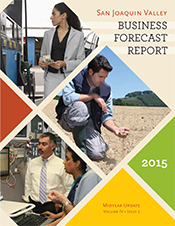Gökçe Soydemir, the Foster Farms Endowed Professor of Business Economics, sees depth of labor force, unemployment figures improving faster than historic and/or benchmark rates.

With the drought continuing to impact Valley life, Soydemir nonetheless reports a slow and steady improvement in the region’s economy, with signs that the recovery will continue through the end of 2015.
View the 2015 Business Forecast Report
Here are some highlights of the report:
Employment
- The Valley unemployment rate, currently 11.70 percent, has decreased gradually in recent years, but this year's decline brings unemployment below the 10-year historical rate for the first time since the recession.
- This year's labor force growth is beginning to more closely parallel employment growth. Since the end of the recession, growth has been positive but losing momentum. This report, however, indicates the reemergence of an influx of the labor force to the Valley.
- Information employment — the production and distribution of information, including data — has declined significantly in previous years but is poised to register an annual growth of up to 3 percent in the coming months.
- Employment gains in non-farm related areas will partially offset the drought-related decrease in agricultural jobs, with total employment figures close to the 10-year benchmark.
- Construction and leisure and hospitality services were the two fastest growing employment sectors, while manufacturing employment stagnated and financial activities employment declined. The report forecasts these dynamics will prevail over the next two years.
- Merced County had the fastest employment growth while Madera County had a slight decline in employment levels. Employment in Stanislaus County grew at roughly the same rate as the Valley average of 1.26 percent.
Inflation and wages
- As inflation continues to be suppressed by the absence of cost-push factors, wage increases are expected to outpace inflation.
Strength of the dollar
- A stronger dollar will equate to lower prices for goods imported to the Valley, but also will result in higher prices for exported goods, which will negatively impact competition in international markets.
Home values
- Home values will grow at a projected 9 percent in 2015 and 5.39 percent in 2016, which is a slower rate than recent years but roughly double the 10-year average.
Banking
- Total deposits in Valley banks will continue to increase simultaneously with net loans and leases.
The Drought
- While effects of the drought began to take a toll on farm-related sectors, they have not yet begun to significantly affect the non-farm related sectors.
The biannual Business Forecast Report provides projections for the Valley's labor market; regional housing conditions; prices and inflation; banks and other depositary institutions; and capital markets. Soydemir and his team use a unique forecasting model that produces lower and upper statistical confidence bands, with results that are expected to fall within this range.
Soydemir joined CSU Stanislaus as the Foster Farms Endowed Professor of Business Economics in 2011. He brings strong expertise and experience in business analysis and forecasting and has published extensively on applied econometrics, regional economics, financial forecasting, market analysis and international finance.